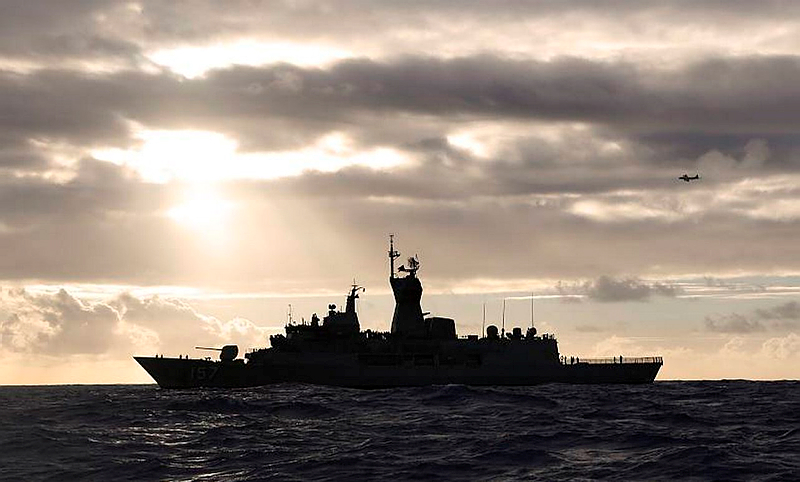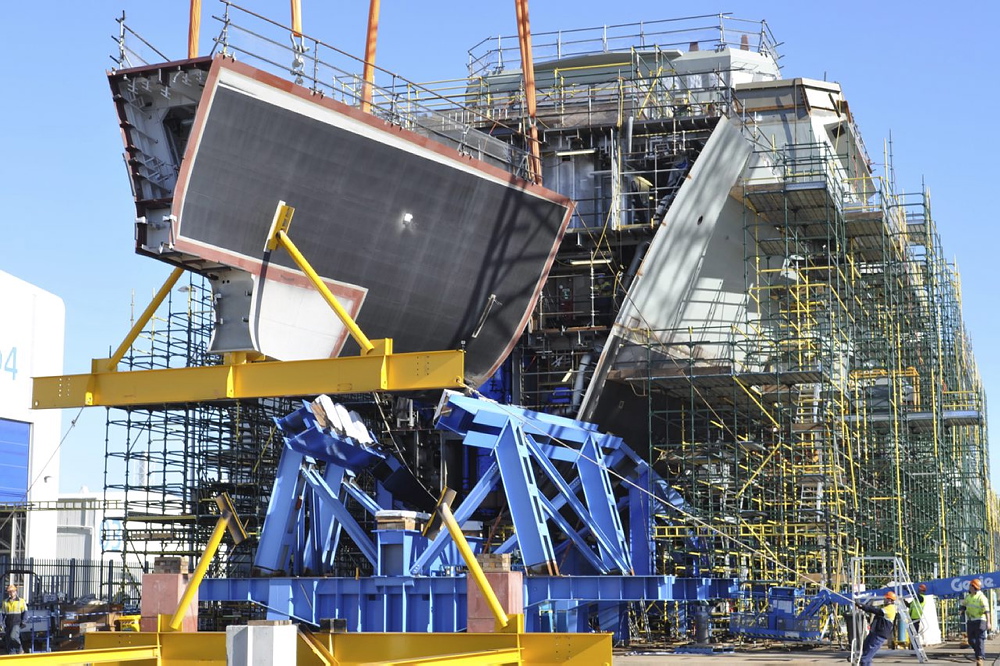Nothing Found
Sorry, no posts matched your criteria
Sorry, no posts matched your criteria
The Future Submarine (FSM) project has been the subject of significant commentary over recent months, leading to the statement by Defence Minister Andrews on 20 February on the structure and conduct of the competitive evaluation that will be undertaken. That statement provided some additional clarity for industry but left many key questions unanswered.
Some of those questions should be addressed in the process that’s now underway, but the odds would have to be against the FSM being constructed in Australia. It remains to be seen whether there’s a hybrid build with some of the systems integration and final fit-out and testing being done in Australia—and importantly, who carries the not-insignificant risks of such a strategy. Read more
Recent events, rumours and reports have cast a light on the future of Australia’s defence industry. High-profile considerations have centred on shipbuilding and submarines with the ongoing Senate Economics References Committee Inquiry, ministerial and prime-ministerial positioning for a ‘Japanese solution’ to Australia’s future submarine, and the ongoing debate about costs and economic benefits.
But it’s also important to step back and consider the future of the broader industry. What’s the current status of the local defence industry? How does it compare with that in other jurisdictions? Is defence-related industry intrinsically different to other sections of the economy? Where are we headed, and is that a good place?
If we take those questions in reverse order it’s clear we don’t know where we’re headed. We’re on a mystery tour and no-one seems to care where it might end. Will it be possible to come back? Decisions on military acquisitions and support seem to be made on the basis of the balance sheet rather than any deeper consideration of strategic importance. Repeatedly, statements are made that the ADF needs to get the best capability for the available money, and that defence isn’t a job-creation programme. At face value both of those statements are sound, but they don’t take into account the longer-term ramifications of in-country industrial activity able to support the defence force. Read more
[latexpage]
An important concept in understanding production efficiency of complex items is the notion of a learning curve. The term has passed into common usage, with ‘steep learning curve’ being synonymous with ‘really hard to master’ (in all sorts of contexts). That badly misrepresents its actual technical meaning; a steep learning curve actually means that something is easy to master. In the case of the production of things like warships, it means that the workforce concerned is getting on top of technical difficulties quickly.
A learning curve can be drawn in a number of complementary ways, but for the purposes of analysing defence projects, the most useful form plots the number of person-hours required to produce each item as production rolls along. Here’s an illustrative example. If the first item takes 1,000 labour-hours to produce, and the learning (in its technical meaning) is 90%, then every time the production numbers double the labour required for each item reduces by 10%. I.e. the second one takes 900 hours, the fourth takes 810 hours, the eighth 729 hours etc. By the time the 25th is produced, it’s taking a little over 600 hours. (See the blue curve in Figure 1, click graph to enlarge) As production times come down, unit labour costs fall as well, though the more productive workforce often shares some of the gains in the form of higher wages.
The worst-kept secret at the DMO Defence and Industry conference this week was the government’s active consideration of buying submarines from Japan. Although it was never mentioned in any presentation, Option J, as it has come to be known, was discussed in every corner and corridor of the Adelaide convention centre.
Good policy rarely results from secret deliberations shielded from public scrutiny, so I think it’s time to discuss Option J directly, at a level beyond passing media speculation.
As recently as a month ago, the Abbott–Abe strategic cozying up seemed likely to deliver little more than access to Japanese submarine technologies—in particular, the propulsion system. But today it appears that the government is actually considering having replacements for the Collins built in Japan. Read more
 It’s a truism that without industry capability, there can be no defence capability. Getting acquisition/industry policy right is therefore essential to getting defence policy right. As the Australian Government prepares to deliver a new Defence White Paper—and the associated Defence Capability Plan and Defence Industry Policy Statement—a simple, clear framework is needed to guide its thinking about acquisition and industry policy.
It’s a truism that without industry capability, there can be no defence capability. Getting acquisition/industry policy right is therefore essential to getting defence policy right. As the Australian Government prepares to deliver a new Defence White Paper—and the associated Defence Capability Plan and Defence Industry Policy Statement—a simple, clear framework is needed to guide its thinking about acquisition and industry policy.
Three core considerations underpin that policy:
 My colleague Mark Thomson despairs over the prospect of the early replacement of Navy’s Anzac frigates on cost-effectiveness grounds. He’s probably right, but I worry instead about the possibility that the capability implications and project complexity have been underestimated.
My colleague Mark Thomson despairs over the prospect of the early replacement of Navy’s Anzac frigates on cost-effectiveness grounds. He’s probably right, but I worry instead about the possibility that the capability implications and project complexity have been underestimated.
Let’s start with the positives of the proposal to develop the Navy’s future frigates around the basic hull and mechanical components of the air-warfare destroyers (their naval designation is DDG) currently under construction. The first—and, in my opinion, the best—reason was well articulated by the Chief of Navy in his ASPI White Ensign Dinner speech, when he pointed out the virtues of commonality of systems across the fleet. For a 52-ship Navy, there’s a surprisingly large number of designers and suppliers in the support network.
Second is the potential for naval shipbuilding to become an ongoing program, rather than a stop/start process. Every new program comes with its own start-up costs, both the direct costs of the people and infrastructure required and the indirect costs of an inexperienced workforce. The AWD/DDG program shows only too clearly how much grief that can cause. By the time a number of ships have been rolled off the line, most of the initial bugs are sorted out and efficient production ensues. By the time the tenth Anzac was launched, production was humming along nicely. Read more
Everyone seemed to miss it—a statement in public (at ASPI’s Submarine Choice conference) from the chairman of the Western world’s largest and most successful builder of conventional submarines: a fleet of 12 large state-of-the-art boats would cost around $20 billion. That’s $16 billion less than ASPI’s own estimate and was given by Dr Hans Christoph Atzpodien, the head of ThyssenKrupp Marine Systems. Since his company has built over 180 submarines since 1960, he should know about submarine costs.
Bizarrely, his estimate appears to have been totally ignored. I saw that my friend and colleague Stewart Cameron has written in The Australian that 12 submarines will now cost around $40 billion. That estimate was repeated by Alan Dupont in the same newspaper and subsequently also appeared in the Fairfax media.
So the estimate of someone who knows well is ignored, while the comparative ‘guesstimate‘ of $40 billion is well on its way to being entrenched as ‘fact’. Read more
 According to the Australian Industry Group (AIG), the headcount at the Defence Materiel Organisation (DMO) has grown three-fold over the past decade from 2,500 people to 7,500. Armed with this remarkable statistic, in their submission (PDF) to the National Commission of Audit they’ve called for DMO staffing to be cut ‘perhaps by half’. For a government on the lookout for budget savings that’s likely to sound attractive, especially with a Defence Minister on the record bemoaning the high number of civilians in Defence.
According to the Australian Industry Group (AIG), the headcount at the Defence Materiel Organisation (DMO) has grown three-fold over the past decade from 2,500 people to 7,500. Armed with this remarkable statistic, in their submission (PDF) to the National Commission of Audit they’ve called for DMO staffing to be cut ‘perhaps by half’. For a government on the lookout for budget savings that’s likely to sound attractive, especially with a Defence Minister on the record bemoaning the high number of civilians in Defence.
But before they start handing out pink slips to the folks at DMO, it’s worth pausing to check the numbers. Has the number of people in DMO really increased by 5,000 since 2004? While it’s impossible to be absolutely precise because of Defence’s habitual lack of disclosure, the answer is unequivocally ‘no’. Read more
 I noted with interest Kym Bergmann’s question in the context of defence industry policy ‘why is “offsets” such a dirty word here’? The answer is actually straightforward: Australia tried offsets—and the results were hardly encouraging. All they did was result in poorly targeted outlays that imposed additional costs on taxpayers and made the procurement process even more inefficient than it would otherwise have been. Yes, they were simple, at least in theory: but it was a classic case of every complex question having an answer that’s simple—and wrong.
I noted with interest Kym Bergmann’s question in the context of defence industry policy ‘why is “offsets” such a dirty word here’? The answer is actually straightforward: Australia tried offsets—and the results were hardly encouraging. All they did was result in poorly targeted outlays that imposed additional costs on taxpayers and made the procurement process even more inefficient than it would otherwise have been. Yes, they were simple, at least in theory: but it was a classic case of every complex question having an answer that’s simple—and wrong.
The problem with offsets is obvious. Essentially, they required offsetting defence acquisition expenditure in Australia to ‘balance’ the expenditure on the program. Naturally, the costs of that expenditure are built into the bids for the program; so the expenditure itself increases, rather than reduces, the burden on taxpayers. As raising taxes involves an efficiency loss (because people change their behavior in response to the taxes), every dollar of added outlay costs more than a dollar in income loss to taxpayers—typically around $1.30. So increasing the cost of a $1 billion project to $1.1 billion, costs at least $130 million in reduced taxpayer income.
 Yesterday saw the launch of the ANAO’s 2012–13 Major Projects Report, which takes an auditor’s eye view of the biggest and most complex defence projects. This year it analyses 29 projects—more than previous, and making this an increasingly rich source of data for those of us who worry about these things. We at ASPI will no doubt dip into this compendium frequently in the months to come, but for now a quick overview will have to do.
Yesterday saw the launch of the ANAO’s 2012–13 Major Projects Report, which takes an auditor’s eye view of the biggest and most complex defence projects. This year it analyses 29 projects—more than previous, and making this an increasingly rich source of data for those of us who worry about these things. We at ASPI will no doubt dip into this compendium frequently in the months to come, but for now a quick overview will have to do.
The report has already made headlines. The Australian yesterday ran a story about the state of the Air Warfare Destroyer project and worried that there might be as much as a $1 billion cost blowout and possible further schedule delays. That’s not directly borne out from the audit report—although a careful reading suggests that potential future troubles loom.
Sorry, no posts matched your criteria